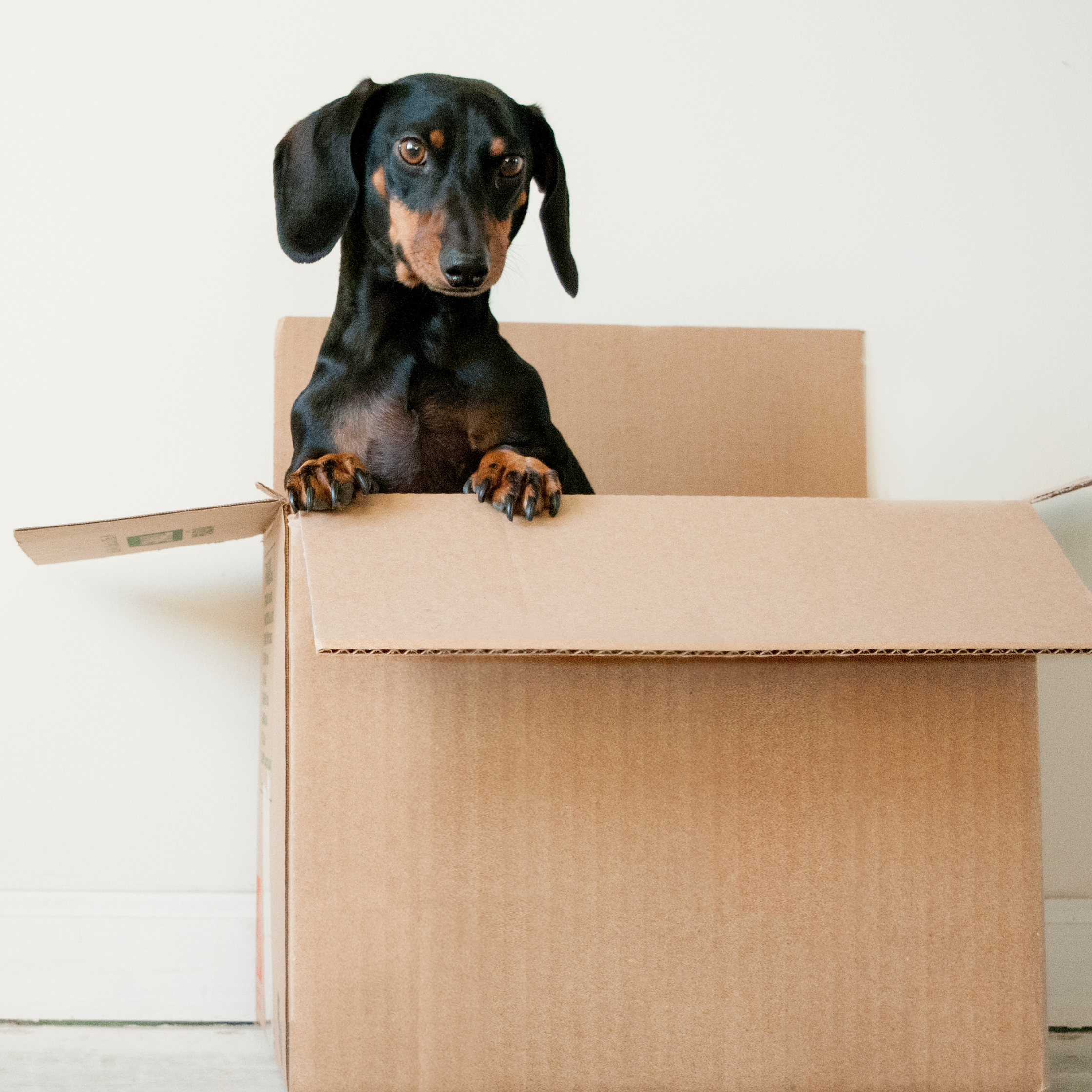How to move home with your dog

Image: Erda Estremera
August is the most popular month for moving home in the UK.
This is a stressful time so think about four-legged housemates who need help to settle into a new home, environment, routines & maybe even different weather.
Non-verbal stress signals can be hard to spot especially if you're busy, so planning before the cardboard boxes arrive is vital.
Your dog’s secret super-power skill is their incredibly advanced sense of smell, so smart use of this can be very helpful during a stressful move.
Spare a few minutes to think about your relocation from their perspective, with the quirky personality and habits of your dog in mind. A little preparation on your part can make a big difference to how quickly they settle in.
The action of packing up home, with its reassuringly familiar scents and objects placed into strange new boxes can be a major disruption for sensitive dogs. Whilst we know exactly what’s going on and why, for your dog it is a disorientating upheaval, with new people and noises coming into their world. And since you are also likely to be stressed and tired, dogs can pick up on this and feel anxious as well. Add-in unfamiliar people (if you're using a removal firm)... who are literally taking everything away (!!), and it’s obvious how this can become a pain-point for those hounds who have appointed themselves as ‘head of home security’.
If you can, moving them to a third location – such as a short stay with a familiar friend or family member – for the duration of the move can be the best option. You can then introduce them to their new home when you are relaxed and familiar things have been extracted from storage. This may not be possible, so below we offer some tips on preparation, transport and settling in.

Image: Karsten Winegeart
Before the move (1 week prior)
- Make sure your collar-tag details are changed to new contact/address if necessary and their microchip data is up-to-date
- Be sure to have a good stock of their regular/ favourite food so there are no sudden step-changes in diet that might cause extra problems
- If possible, bring packing materials such as boxes/crates, tape, wrap and paper into the house ahead of time so that they become familiar smells and sights – but ensure these can’t be chewed or played with (especially bubblewrap)
- Get into the habit of collecting prized toys, games, blankets, cushions etc into one place (a box or if your dog is used to it, a crate) as these will provide a sense of security/distraction on-the-day and be helpful in the new home. Move these things last on the day.
- Don’t wash bedding, clothes or toys until the move is completed as the familiar smell of these will be a big asset to create comfort during the move and in the new home.
- Identify a room that will become ‘their space’ for the move-out day and remove as much as furniture/possessions as possible from that before the day. Familiarise them with being enclosed in it (ALWAYS with access to water) for short periods of time to get relaxed… add a chew-toy or stuffed Kong as well to make it fun.
- Research walking routes near the new home so that at the end of moving day you can take them out for some welcome exercise
- Consider identifying a new vet in the new area ahead of time, so that if you do need them you have details to hand. Better to have this ready than be in a panic if there’s an injury or urgent problem.
Moving day: leaving
- Keep to as much of your usual routine as possible: morning walk, feeding times etc. To avoid illness en-route, feed in advance of the final exit time.
- Appoint a member of the family to ‘dog duty’ and make sure they always know where the dog is. With new people in/out of the house, doors and gates kept unusually open and other odd changes to environment, the last thing you need is to be chasing down an anxious dog on the loose.
- Empty the dog’s appointed space first, so that they can be transferred into it and settle in with water, toys etc. whilst you are occupied with the rest of the house. Place a note on the handle of the door – this will also help in case anyone involved in the move is not a dog lover…
- It might feel harsh to leave them alone, but this will prevent an unwanted escape, possible injuries and is much less stressful for your dog overall.
 Image: Andrew Pons
Image: Andrew Pons
Moving day: transport
- A crate is the best method of moving your dog over long distances, but only if they are familiarised with it well in advance. If they are used to a particular scent or fragrance, like a cologne spray, use this on the bedding in the crate and car.
- A well-exercised dog is more likely to settle into a journey easily, so try to ensure a good walk before transporting.
- Don’t keep your dog loose in the footwell of the car, in the boot or in a removal van. In a car, they should be secured with a harness/seat-belt or behind a fitted dog guard. The rule is that they should be able to stand up, sit and lie down comfortably.
- On a stressful day, loo-breaks might be required more frequently than usual so plan these out and make pitstops for water and short walks along the way.
- Keep in mind that during the move you’re likely to be distracted, so don’t risk the dog becoming locked in a hot car – the sun moves even if the car is shaded when you parked and temperatures inside can rise very quickly. It’s best not to leave them alone in a car at all on moving day.
Moving day: arrival
- Keep your dog on a lead with the appointed person until a space can be secured for them in the new home. Place in this space the same items from your old home: water, chew-toys, treats and consider labelling the door again, to prevent accidental releases
- Alone in an unfamiliar room, nervous dogs may still want the reassurance of being able to see, hear (and smell!) you… a stair-gate across an open door threshold is great
- When your belongings are in and external doors can be secured, allow your dog to roam freely around the new space to get familiar with it in their own time.
- Be sure to double-check outdoor areas are completely secure before allowing them to roam around… particularly gaps in garden fences, or balconies with insufficient barriers.
- Scent can be incredibly reassuring, so be sure to set up their bed or sleeping area with familiar blankets and toys. A dog’s sense of smell is more than 40 times more powerful than ours, so a room can fill with reassuring aromas that you will likely barely notice. Place something familiar in a few common areas of the home.
- Tempting as it may be to replace the worn-and-dented food bowl, or the slightly unsightly drinking bowl, these are comfortingly familiar things for your dog so it’s a good idea to keep them for the move.
- Similarly, if your new space has been used by a previous dog, try to remove or limit exposure to furniture that may have their scent on it. Spray products familiar to your dog on these items/spaces
- A new home is likely (…hopefully!) to have been cleaned thoroughly for your arrival. Bear in mind that these chemicals and synthetic aromas – designed to reassure human noses of cleanliness – can be very distressing to a dog’s advance sensory perception. If there is a strong aroma of cleaning materials that you can detect, this is likely to be overwhelming for your dog. Ventilate rooms by opening windows.
- After a long day, it’s likely they will appreciate a good walk around the new neighbourhood. Allow your dog to smell their new environment as this is how they will learn where they are and catch up on all the ‘local news’ from other dogs who have left their marks.
 Image: Matt Odell
Image: Matt Odell
Settling in
- With familiar things, smells - and of course people – some dogs will settle in very quickly, whilst others may need more time to adjust... this can be days, or months, so your patience will be valued.
- Spending time on the floors with your dog will help to spread your scent at their nose-level and accelerate the adaptation of their new environment to one they recognise. This also builds bonding time and trust in the new spaces.
- Sticking to the pre-move routine will help reduce the stress of the change, although you may have to reduce ‘alone time’ until they are fully adjusted.
- In the early days, keep walks on a lead. You can expand this to long-lead or extendable leashes to allow some freedom to explore and return.
- Stress-related behaviours such as chewing and house-training problems may appear temporarily. Don’t scold - reduce the opportunity for this to be problematic for you by avoiding exposure to areas with expensive carpets or furniture, until settled in. Reward the behaviour that you want (e.g. toileting in the right areas) with treats and praise
- Consider renting a GPS tracking collar/tag in the early weeks
-
Posted in
anxious dogs, aromatherapy, august, boxes, care, dog care, moving house, smells, sniffology, stress




